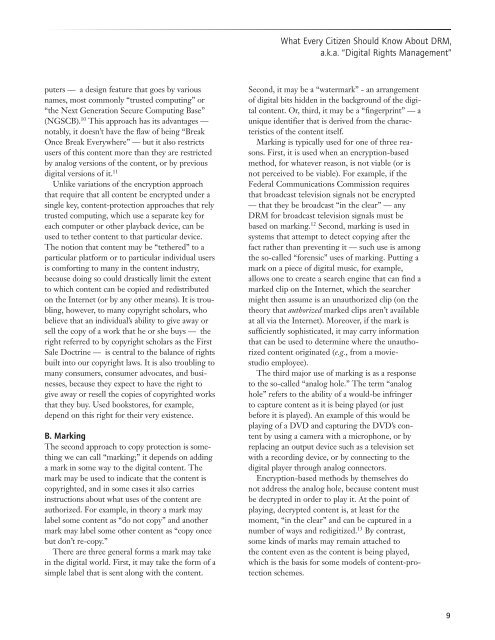What Every Citizen Should Know About DRM, aka - Public Knowledge
What Every Citizen Should Know About DRM, aka - Public Knowledge
What Every Citizen Should Know About DRM, aka - Public Knowledge
You also want an ePaper? Increase the reach of your titles
YUMPU automatically turns print PDFs into web optimized ePapers that Google loves.
<strong>What</strong> <strong>Every</strong> <strong>Citizen</strong> <strong>Should</strong> <strong>Know</strong> <strong>About</strong> <strong>DRM</strong>,a.k.a. “Digital Rights Management”puters — a design feature that goes by variousnames, most commonly “trusted computing” or“the Next Generation Secure Computing Base”(NGSCB). 10 This approach has its advantages —notably, it doesn’t have the flaw of being “BreakOnce Break <strong>Every</strong>where” — but it also restrictsusers of this content more than they are restrictedby analog versions of the content, or by previousdigital versions of it. 11Unlike variations of the encryption approachthat require that all content be encrypted under asingle key, content-protection approaches that relytrusted computing, which use a separate key foreach computer or other playback device, can beused to tether content to that particular device.The notion that content may be “tethered” to aparticular platform or to particular individual usersis comforting to many in the content industry,because doing so could drastically limit the extentto which content can be copied and redistributedon the Internet (or by any other means). It is troubling,however, to many copyright scholars, whobelieve that an individual’s ability to give away orsell the copy of a work that he or she buys — theright referred to by copyright scholars as the FirstSale Doctrine — is central to the balance of rightsbuilt into our copyright laws. It is also troubling tomany consumers, consumer advocates, and businesses,because they expect to have the right togive away or resell the copies of copyrighted worksthat they buy. Used bookstores, for example,depend on this right for their very existence.B. MarkingThe second approach to copy protection is somethingwe can call “marking;” it depends on addinga mark in some way to the digital content. Themark may be used to indicate that the content iscopyrighted, and in some cases it also carriesinstructions about what uses of the content areauthorized. For example, in theory a mark maylabel some content as “do not copy” and anothermark may label some other content as “copy oncebut don’t re-copy.”There are three general forms a mark may takein the digital world. First, it may take the form of asimple label that is sent along with the content.Second, it may be a “watermark” - an arrangementof digital bits hidden in the background of the digitalcontent. Or, third, it may be a “fingerprint” — aunique identifier that is derived from the characteristicsof the content itself.Marking is typically used for one of three reasons.First, it is used when an encryption-basedmethod, for whatever reason, is not viable (or isnot perceived to be viable). For example, if theFederal Communications Commission requiresthat broadcast television signals not be encrypted— that they be broadcast “in the clear” — any<strong>DRM</strong> for broadcast television signals must bebased on marking. 12 Second, marking is used insystems that attempt to detect copying after thefact rather than preventing it — such use is amongthe so-called “forensic” uses of marking. Putting amark on a piece of digital music, for example,allows one to create a search engine that can find amarked clip on the Internet, which the searchermight then assume is an unauthorized clip (on thetheory that authorized marked clips aren’t availableat all via the Internet). Moreover, if the mark issufficiently sophisticated, it may carry informationthat can be used to determine where the unauthorizedcontent originated (e.g., from a moviestudioemployee).The third major use of marking is as a responseto the so-called “analog hole.” The term “analoghole” refers to the ability of a would-be infringerto capture content as it is being played (or justbefore it is played). An example of this would beplaying of a DVD and capturing the DVD’s contentby using a camera with a microphone, or byreplacing an output device such as a television setwith a recording device, or by connecting to thedigital player through analog connectors.Encryption-based methods by themselves donot address the analog hole, because content mustbe decrypted in order to play it. At the point ofplaying, decrypted content is, at least for themoment, “in the clear” and can be captured in anumber of ways and redigitized. 13 By contrast,some kinds of marks may remain attached tothe content even as the content is being played,which is the basis for some models of content-protectionschemes.9





